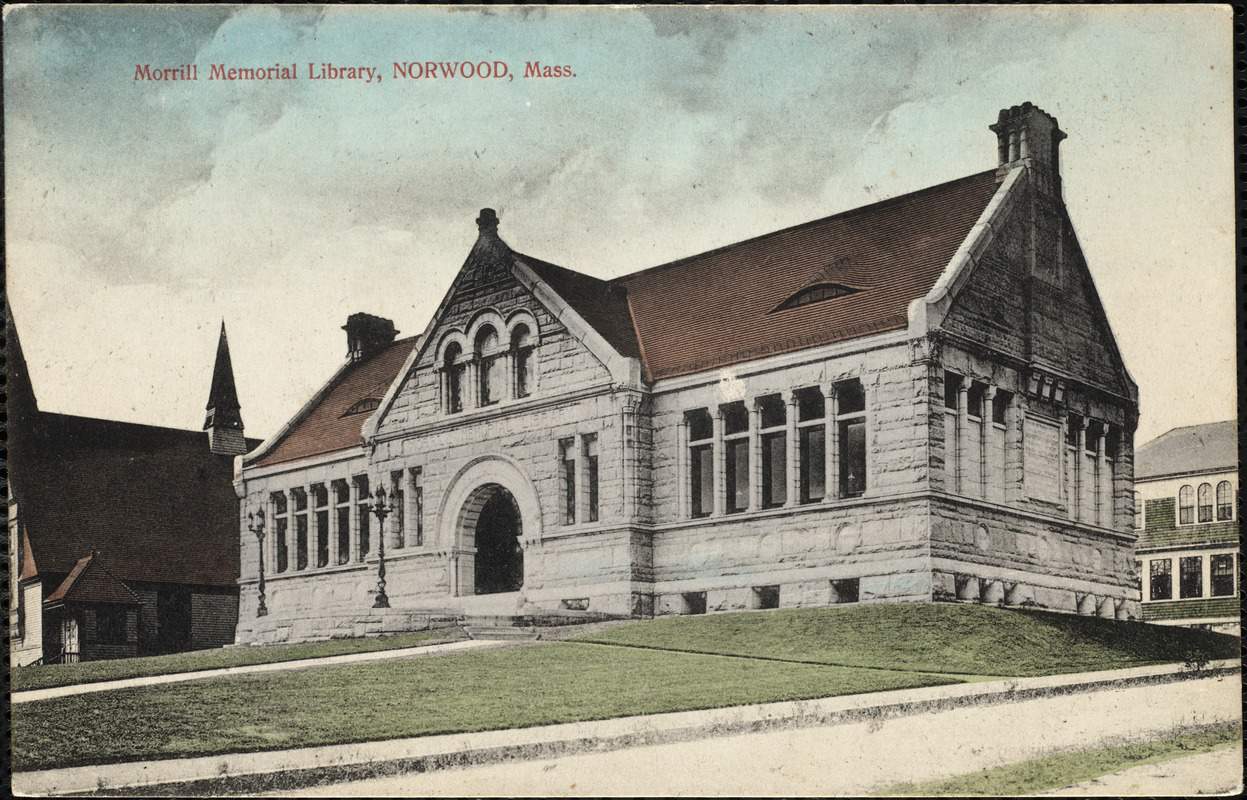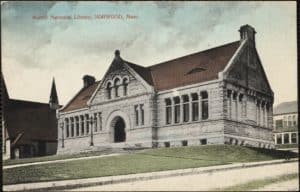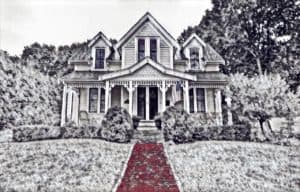Tag Archives:History

3
DecMore than a Century of Directorship
 A few weeks after the new year begins, I will box up the last of my personal items from my office on the Morrill Memorial Library’s second floor. The elegant 123-year old mahogany-lined walls, nearly floor-to-ceiling bookcases, leaded glass, and six-foot windows in the Director’s office have been home to me for the past twelve years. When I lived closer to the library (in Norfolk until 2012 and Norwood until 2018), I would often drop in to the library to spend a weekend afternoon. I spent many more darkened hours on weeknights surrounded by urgent library work. Yet, any time of the day, I was satisfied in the interior light of an institution that has provided Norwood residents with vibrant library service for well over a century.
A few weeks after the new year begins, I will box up the last of my personal items from my office on the Morrill Memorial Library’s second floor. The elegant 123-year old mahogany-lined walls, nearly floor-to-ceiling bookcases, leaded glass, and six-foot windows in the Director’s office have been home to me for the past twelve years. When I lived closer to the library (in Norfolk until 2012 and Norwood until 2018), I would often drop in to the library to spend a weekend afternoon. I spent many more darkened hours on weeknights surrounded by urgent library work. Yet, any time of the day, I was satisfied in the interior light of an institution that has provided Norwood residents with vibrant library service for well over a century.
Many times over the past decade, I would rise from my chair in my quiet office, one in which I had just spent hours at my computers on spreadsheets and memos. I would glance around the entrance and tall wooden office door to watch the work of my peers – those librarians whose commitment and perseverance always astound me. I would smile at the morning gentleman or the group of afternoon mothers who surrounded our jigsaw puzzle table, finishing yet another 1000-piece challenge. I would hear captivated children sing and clap during yet another story hour in the Simoni Room. I would listen to our tired, but dutiful grandfather clock chime the hour. One of my favorite things to do was to lead visitors on a tour of the second floor, as I pointed out the beauty of the stained-glass windows, multiple fireplaces, and details of the 19th Century architecture. I never neglected to expound on the generosity of the Morrill family, and I could endlessly gaze at the beauty of this library given to the Town in 1898 in honor of a daughter, a young Sarah Bond Morrill, who died at the age of 23.
In January 1898, when thirty-two-year-old “Jennie” Hewitt spent her first day in the new Morrill Memorial Library, she was accompanied by one assistant. Both of their salaries totaled a bit over $300 per year. Ms. Hewett came from Canton, MA, where she had worked at the Canton library. Many libraries did not require a master’s degree in librarianship in 1898, and Hewett did not have one. However, the Norwood trustees were fully assured that Hewett would triumphantly lead the library through the turn of the 19th century.
And she did lead, for three more decades. By the time she retired in 1939 in her seventies, her staff had grown to seven assistants. The library’s holdings and circulation had increased by thousands, and the Morrill Memorial Library possessed what might have been the first Young Adult (Intermediate) Room in the Commonwealth. She was far ahead of her time, recognizing the importance of community involvement and her own professional work outside of Norwood. Norwood had weathered WWI, the Pandemic of 1918, and the economic crash of 1929. Upon her retirement, the Daily Messenger, one of Norwood’s newspapers, awarded Hewitt Forty-One Gold Service Stars for her 41 years of service. The townspeople saluted her, and the trustees regaled her.
In 1939, Edna Phillips stepped into Ms. Jennie’s shoes. Edna was, perhaps, the most professional and accomplished director the library has known. She started her career as a librarian near her home in Edgewater, New Jersey. Dutifully, she served in WWI from 1918-1919 in both France and Germany with the YMCA. She returned home to continue her work as a librarian in East Orange, New Jersey. Obviously, both courageous and energetic, Edna was also intelligent and was awarded a Carnegie Fellowship at Columbia University. She came to Massachusetts as the director of the Sawyer Free Library in Gloucester.
While working in Norwood from 1939-1962, she was professionally connected across the country. She served on the American Library Association Council and traveled to conferences in San Francisco, Chicago, and Florida. She spoke locally across the Commonwealth and regionally across New England at conferences and workshops. She contributed book lists on the cultural achievement of the North American Indian and led seminars on immigrant relations.
Unfortunately, the Massachusetts Legislature abandoned the practice of delaying mandatory retirement at the age of 65, and Ms. Edna was forced to retire at the age of 71 in 1962. In a tribute by the Norwood Woman’s Club, it states that “for her graciousness and serenity [she] is a shining example of effective womanhood.” Like Jane Hewitt before her, Edna was a devoted public servant and beloved librarian. When she passed away in 1968, she left a sizeable portion of her will. In the library’s renovation in 2001, the second floor’s reference room was dedicated as the Edna Phillips Reference Room.
From 1963 to 1968, Charles Joyce was perhaps the most notorious library director, as library directors go. His directorship was marked by finishing a complete renovation and expansion of the library in 1964, doubling the library’s size and moving the front door close to Walpole Street. He hired a staff of master-degreed librarians who dared to move the library far into the 20th Century. In the winter of 1968, however, Joyce and all of his professional staff resigned over a controversy with the library board of trustees.
In September of 1968, Barbara Jordan from Pittsburgh, PA, was appointed director. She was originally a Norwood native, and upon her return to Norwood, she brought 35 years of experience to the library. Just two brief years later, she retired from the library. Her achievements were acquiring a lending library of art and a microfilm reader.
Virginia Pauwels arrived in the winter of 1971 from Texas. During her tenure, she published a short pamphlet which was a criticism of Henry Ward Beecher’s Norwood or Village Life in New England.
Norwood was a fictional town of 5,000 in western Massachusetts, written by Beecher in 1868. Whether or not the Town of Norwood was named after this fictional account is doubted by many. Pauwels retired in the winter of 1973 to take a position in southern California. Interestingly, she had just attended a conference there and missed the “vastness of the West.”
Carl Himmelsbach succeeded Pauwels as library director in the fall of 1973. From New York state, Mr. Himmelsbach received his master’s degree from the University of Rhode Island and lived in Franklin when appointed. He and librarians in Dedham and Westwood were instrumental in developing a library in the Norfolk County House of Corrections. Himmelsbach oversaw enormous technological changes in the 80s and encouraged the expansion of the outreach program. With trustee Eleanor Monahan, Himmelsbach developed the successful literacy tutor program that is a now a shining example in the Commonwealth. In 1988, he retired after 14 years of directorship.
Mary Phinney had come to Norwood as the Technical Services librarian in 1971, hailing from Amelia Island off the coast of Florida. To this day, Mary makes Norwood her home. When she was promoted in 1988 to the directorship, Mary quickly began work with the trustees to plan a major renovation project to the building, then nearly a century old in 1988. Mary, the trustees, and the Town’s building committee took a modern 1965 addition, one that took away from the beauty of the 1898 building, and planned a library that blended new technology and diverse collections with the library’s original classic architecture. Mary led the library through admission into the Minuteman Library System. She retired in 2008 after twenty years of directorship.
I take enormous pride in the honor of having been the eighth director of the Morrill Memorial Library in the past 123 years. My twelve year term of service in Norwood was not the longest, nor the shortest. I followed seven other passionate and dedicated directors, all public servants. I know that others with that same passion will come after me. In a few short weeks, that new director will be chosen, and his or her personal books, artwork, and photographs will make the 2nd-floor director’s office home to a new administration. I am assured that this new directorship will be with the same awe, passion, and dedication to serving the Town of Norwood.
Charlotte Canelli is the Director of the Morrill Memorial Library in Norwood, MA. Look for her article in the December 3, 2020 issue of the Transcript and Bulletin.

9
NovNorwood: A Home Town
 When we moved to Norwood in 2012, I was excited about owning a historic home that was within walking distance to both my work at the library and the town’s center. I wondered how many families had placed their hands on the sturdy wooden banister leading from the second floor. I imagined other women lovingly serving meals for family and guests in the spacious dining room. I was curious about the children and adults who might have peeked out the windows to watch passersby or wait for Halloween trick-or-treaters to knock on the distinctive double doors.
When we moved to Norwood in 2012, I was excited about owning a historic home that was within walking distance to both my work at the library and the town’s center. I wondered how many families had placed their hands on the sturdy wooden banister leading from the second floor. I imagined other women lovingly serving meals for family and guests in the spacious dining room. I was curious about the children and adults who might have peeked out the windows to watch passersby or wait for Halloween trick-or-treaters to knock on the distinctive double doors.
I wished there were photographs hidden in far reaches under the eaves of the deep closets, but there were not.
Working as a librarian certainly has its benefits because I knew just where to look to locate a bit of the house’s history and inhabitants. All of this information can be accessed by anyone who visits Norwood’s history collection in the Cushing Reading Room. Both the Annual Town Reports (now digitally available through the Minuteman Library Network catalog) and Norwood Street Lists are there for anyone to use to research.
Included on those history shelves (while under lock and key, the Adult Information Services librarians will be happy to help unlock them) are two volumes – Norwood: A Home Town. They are rich in architectural detail and structural information that was compiled by both the Norwood Historical Commission and the Massachusetts Historical Commission in the last two decades of the 20th Century. Hundreds of Norwood’s homes are listed by street address; pages that begin with Atwood Avenue and end with Winter Street. Most of the historical descriptions of the hundreds of homes were written by researcher Edward Gordon.
Norwood: A Home Town begins with details of the Town of Norwood’s districts and commercial buildings. Norwood Center, or “the hook,” the F. Holland Day House, the Winslow Brothers tannery complex are all described and illustrated. The town’s amazing presses, among them the Norwood Press and the Plimpton Press, are included. Of particular interest to me are the pages devoted to George H. Morrill & Co. Printing Ink Works. It was George Morrill who built Norwood’s library with his own funds, in memory of his daughter. Like Carnegie of the same era, Morrill shared his wealth and handed over the keys to the library to the town in 1898.
Morrill eventually moved his ink company out of Norwood and consolidated with four other ink companies. In 1945 the Geo. H Morrill Company Division of General Printing Ink Corp was renamed Sun Chemical Corporation.
In 2012, when I decided to research my new home on Prospect Street, I went to the Norwood: A Home Town and the Norwood Street Lists. 305 Prospect Street is listed merely as the Samuel Page House, named for its first owner. It was built in either the 1870s or 1880s on land purchased from the Fairbanks family. On a late 19th century map of Norwood (that can be found in the library’s map drawers), everything north of Prospect Street from Winter to Nahatan streets was illustrated as woods or farmland. This was truly the edge of Norwood’s town center just south of Westwood.
In 1989 the home included a barn in the rear which was removed sometime in the late 20th century. The actual date the house was built is unknown; there was a residence there in 1876, and Samuel Page was listed in the town’s Street Listing as residing there in 1880. However, there is a period when he was listed as living at 276 Prospect Street between 1897 and 1900. Whether mistakes were made, or Samuel moved out to rebuild his home after a fire destroyed the original is unknown.
The architectural character of the house, however, was of the 1880s and today might be thought of as hybrid, encompassing the Stick, Victorian and Queen Anne styles. What we might call Gingerbread is a particular characteristic with overlapping multiple-sided shingles and pretty trim. Perhaps Samuel built it over the years, finally inhabiting it with a family in 1900.
From the Town of Norwood’s Street Listings early in the 20th century, Lillian Page is listed as the resident of the house between 1908 and 1922. She is presumably Samuel’s daughter, or perhaps a younger wife. She left the home in 1922.
The 37-year period between 1922 and 1959 saw three families in the home, two of them staying only ten or eleven years each. Twenty-seven-year-old Joseph Youlden and his wife Dorothy, five years younger, might have raised their family there. Children under twenty were not listed in the Street Listings. In 1939 thirty-five-year-old Harry Fraser (a landscape architect) and his wife, Helen moved to Prospect Street from Highland Street – from perhaps a much smaller home that is not listed in the Norwood: A Home Town. In 1949 Raymond and Grace Rafuse, both in their fifties, moved from a house across from the Highland Cemetery on Winter Street. Their two working daughters lived with them, Gladys was born in 1920, and Jean was born in 1925.
It was in 1959 that John Payne moved into the home from Dedham and lived there for 41 years with his wife, Jeannette. For a time, a young nurse named Mary Orphan lived with them. There were several anecdotal stories about the Paynes – there were teenage daughters who had parties there. Jeannette died in 1988, and the home then lost its attentive care. It was in particularly neglected shape when a young hockey-minded couple from the area, Timothy and Anne Lovell, purchased it in 2001. They restored much of its charm and character, added a long brick walkway to the front porch, and renovated the kitchen and baths. They lived there with their four young children until 2012.
We loved living in such a sweet and gentle home in one of Norwood’s lovely neighborhoods and will miss much about the house, particularly its front and side porches. We watched lightning storms travel south as we rocked on our glider on the left front porch, hidden by the azaleas and Boxwood bushes. We admired joggers and dog walkers who took in their exercise every morning and night. From the private side porch off the kitchen, we sipped morning coffee, our feet propped on the white railing.
Approaching cars shown lights in our dining room windows as they turned the corner from Cottage Street heading east towards Dedham. Through open windows, we heard the sirens of Norwood’s most exceptional fire and police departments and listened to the faint sounds of concerts on the Town Common. In the wee morning hours near 4 am, we were sometimes sleepily awakened by the sound of the commuter rail’s train whistle.
Lucky for us, we will commute from our home on the South Coast to our jobs in Norwood, a Town in which we truly feel “at home.” If you want to know more about the houses in Norwood, visit the library’s historical collection in the Cushing Reading Room.
Charlotte Canelli is the Director of the Morrill Memorial Library in Norwood, Massachusetts. Read Charlotte’s column in the November 8, 2018 edition of the Norwood Transcript and Bulletin.
